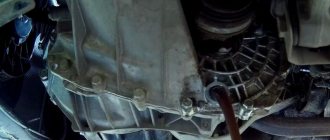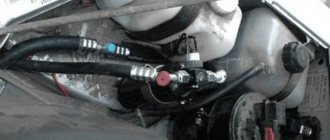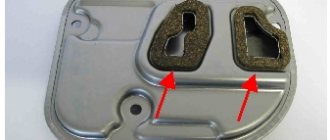By the time of the next technical inspection of the car, the owner should be fully armed and familiarize himself in advance with the range of oils suitable for the VAZ-2114 gearbox. You should be especially careful about the replacement procedure at high mileage, because then the car requires increased attention.
How much oil should I add to the VAZ-2114 gearbox? According to the manufacturer, the volume of the VAZ-2114 gearbox is 3.5 liters . Due to the fact that when changing the oil, a certain amount of transmission fluid remains on the walls, the amount of oil will be approximately 3.3 liters .
Recommended oil types
Lubricating fluids of the GL4 . Synthetic, semi-synthetic and mineral types of oils are suitable for the VAZ-2114 Most often, car enthusiasts choose the following options:
- 75w90
This type of oil is synthetic . It is ideal for vehicle use in low temperature conditions and has excellent lubricating properties. It is this type of transmission fluid that is recommended by the factory for the VAZ-2114. The disadvantage is the increased noise level compared to semi-synthetic analogues.
- 85w90
Representative of the semi-synthetic type. It has a lower cost than synthetic oils and is well suited for high mileage vehicles.
- 80w90
This is a mineral lubricant for gearboxes, which many car enthusiasts consider the best choice for the VAZ-2114 gearbox . Disadvantages include high price and instability to low temperatures due to increased viscosity.
Keep in mind that when replacing lubricating fluid, you cannot mix different oils; this can lead to costly repairs.
Tolerances of transmission oil for a VAZ car
API classification – GL-4
The corresponding classification according to GOST is TM-4. Such oils are suitable for use in conditions of varying severity - from light to heavy. Used in synchronized gearboxes. The use of oils of a different class may increase the wear of gears and gearbox synchronizers.
SAE classification
Mineral 85w90. Suitable for high mileage gearboxes. Has good lubricating properties in hot weather. Due to its high viscosity, it thickens at low temperatures, making it difficult to start the car. The box operates almost silently. Inexpensive cost.
Semi-synthetic 75w90. Lubricating properties at a high level. In warm climates it remains quite viscous. In winter it warms up quickly. Reduces gearbox noise level. Mid price segment.
Synthetic 75w90. In summer, due to high fluidity, it becomes liquid
Particular attention should be paid to gearbox seals; oil leaks are likely. Does not thicken in the cold, makes it easier to start the car
The gearbox is quite noisy. High price.
When choosing a manufacturer, you should proceed from financial capabilities and recommendations of sellers.
Video on the topic of choice:
Among the 75w90 group oils, the following options are especially popular:
- Shell Getribeoil EP
- Eneos
- Castrol Syntrans Transaxle
These lubricants are somewhat more expensive than other oils, but their composition is significantly superior to their analogues.
The best choice in the 85w90 would be the following brands:
- MOBIL Mobilube LS
- JB GERMAN OIL GL4
- Gazpromneft SUPER
For type 80w90 the following oils can be distinguished:
- Motul MOTUL HD
- LIQUI MOLY Marine Gear Oil
- Castrol Manual EP
Liquids from these manufacturers are considered the best in terms of price-quality ratio.
Installation of automatic transmission on front-wheel drive VAZ cars
For car enthusiasts, such an upgrade costs $1,500 (or $1,350 if the car owner leaves his old gearbox, starter and clutch for service). For comparison: the difference between versions of the same Matiz with approximately the same configurations, but with different transmission options, averages $1,400.
The warranty on all work performed and installed units is 2 years or 50 thousand km, whichever comes first. I found about the dynamics of a car with an automatic transmission on the website of a company that installs automatic transmissions. I can’t say how true they are; I haven’t tested them myself.
The torque characteristics of this engine are not conducive to fast starts, so you will have to forget about traffic light races. But after spinning the engine to 2,500 - 3,000 rpm, the situation, as one would expect, changes seriously.
The car reacts sensitively to the slightest movement of the accelerator pedal, and responds to the “kick-down” mode almost instantly: the electronics quickly shifts the gear to a lower gear and cranks the engine to maximum speed, after which it moves to the next stage. It changes insignificantly and fuel consumption will not exceed 10 liters per “hundred” in urban mode.
Decide for yourself whether to install an automatic on your car or not. For girls, I think it makes sense to make driving easier for themselves, and for men who love a sporty driving style, mechanics don’t bother you if you don’t spend 24 hours a day in traffic jams. Perhaps, over time, the technology of “automation” will be brought to perfection - then all that will remain is to admire the tenacity and ingenuity of Russian craftsmen.
My blog is found using the following phrases
My blog is found using the following phrases
My blog is found using the following phrases
Tags: transmission, tuning
The entry was published on June 15, 2009 at 12:35 pm and posted in the Additional equipment section on 15th. You can follow the discussion about this post using the RSS 2.0 feed. You can leave a comment or link back from your site.
Synthetics
When choosing synthetic gearbox oil, the motorist needs to pay attention to the temperature conditions for which the purchased product is designed. These are the last two digits in the encoding.
The main advantages of synthetic oil are that it prevents the formation of toxins, reduces power loss when the engine warms up, and ensures efficient operation of the car in the long term. Buy synthetic lubricants only from trusted sellers, since by saving a few hundred rubles you can run into a fake and spend much more money on eliminating the damage caused. The best synthetic oil for the VAZ-2114 is Castrol Edge Titanium FST.
What quantity should I fill?
3.3 liters of oil
Take another litka for topping up!
Before going to the store, it would be nice to find out how much oil can fit in a VAZ-2114 box. This information should not be neglected, since buying excess oil will incur extra costs, but if you buy insufficient fluid, you will not be able to complete the oil change process completely.
If we ask the manufacturer for advice, we can understand that we need 3.3 liters of transmission oil. But you won’t find exactly this quantity in the store; there will be 1, 3 and 5 liters. Here it’s your choice, you can take two containers for a total of 4 liters, or you can buy 5 liters. The remaining oil will never be superfluous; you will always have it at hand at the right time.
How to change the gearbox oil yourself
To do this, you need to arm yourself with a container for draining used oil, keys “8” and “17” and perform the following steps:
- First, it is important to determine the oil level in the gearbox . To do this you need to find a dipstick. Be sure to remove oil traces using a lint-free rag. Then return the dipstick to its original position. After a couple of minutes, remove it again. Find the maximum and minimum marks on the dipstick, and then compare with where the oil mark is located. This way you will find out how much oil is missing.
- Before changing the oil, it is necessary to warm it up. To do this you will need to drive a little. This is necessary so that the old oil flows out faster. After a short trip, drive your car onto the overpass. Remove the protection and remove the dipstick. Then you need to carefully unscrew the drain plug and immediately place a container for used oil. Before moving to the next step, make sure that all transmission fluid has drained from the transmission. It can take some time. Tighten the drain plug.
All that remains is to fill in new oil. Insert the funnel and hose into the hole from which you removed the dipstick. Fill with 3.3 liters of the selected lubricant. Be sure to check the level with a dipstick.
How is replacement carried out - stages
In addition to the video demonstrating the process of changing the lubricant in the VAZ 2115 gearbox, we will provide a description of the sequence of actions.
- Using a knife, we cut off the side of the canister or bottle, making a kind of “bath”.
- Before starting work, be sure to warm up the gearbox by driving a VAZ 2115 for about 10 km with a warm engine. In this case, the gears will be able to distribute the lubricant throughout the gearbox.
- We lift the right side of the car with a jack, lay down a block or stand and lower the car. Under no circumstances should you work under a vehicle that is simply supported by a jack.
- In case of a cold floor, we place a plywood sheet under the VAZ 2115.
- Wearing gloves and grabbing a canister and a 17mm wrench, we lay down under the car. If there is a crankcase protection, there may be a cut in it under the oil plug. The plug itself is located at the bottom of the left flange of the gearbox.
- If there is no cut, the engine protection must be removed. To do this, clean the plug with a brush and wipe the adjacent area with a rag, then use a 17 mm wrench to unscrew the plug, placing a canister underneath into which warm liquid will flow.
- After waiting 10-15 minutes for the lubricant to completely come out, we install the plug in place.
- Using a knife, cut off the bottom of a one and a half liter plastic bottle.
- We dismantle the intake pipe and air filter by removing the terminal from the mass air flow sensor. Then we twist the clamps at the crankcase pipe and throttle body to completely remove the intake assembly.
- We take out the oil dipstick in the gearbox, located in the upper part, not far from the passenger compartment.
- The neck of the bottle without a bottom is placed against the hole under the cork, as a result of which the bottle acts as a funnel - no more than three liters of oil should be poured into it, after which we check for lubricant leaks from the cork within ten minutes.
- If liquid does not drip from the plug, if necessary, replace the engine protection and remove the VAZ 2115 from the stand.
- Using the dipstick, we continue to pour oil into the gearbox to the maximum mark - in total, the gearbox should hold 3.2 liters of oil.
- In the reverse order described above, we return the filter and inlet pipe to their place.
At first, it is recommended to fill in no more than 2 liters of oil. Then you should check for leaks in the drain plug under the car. To do this, wait about ten minutes, and then continue to pour the lubricant.
Main types and parameters of materials
Fluids that can be used in the operation of a gearbox are divided into three categories:
- Mineral - made by refining oil. They have a high level of viscosity and can be used in units with a long service life.
- Synthetic - a product of chemical synthesis. More fluid materials have reduced sensitivity to overheating and low temperatures.
- Semi-synthetic - a mixture of “mineral water” and “synthetics” in certain proportions. They retain all the important properties of the constituent components.
Transmission oil fluidity level
The main parameter of the oil is its viscosity, which determines the degree of fluidity of the liquid depending on changes in the temperature conditions of the unit. All types of gearbox lubricants are necessarily saturated with additives, which significantly improve their properties and extend the life of the mechanism. Additives, featuring a complex chemical composition, can resist foaming of liquids and the formation of “scoring” on parts. The composition and parameters of the mixture are very easy to find out - all detailed information about its characteristics must be indicated on the packaging.
FAQ
When to change?
A complete change of lubricant in the gearbox should always be carried out only after the car has driven 60,000 km. However, if the vehicle is operated in difficult conditions, the procedure must be performed twice as often. The gearbox of a VAZ-2114 vehicle contains no more than three liters of oil.
Is it necessary to specially prepare the vehicle for TM replacement? No special measures are required. It is important to warm up the lubricant a little - to do this, simply drive the car for a while. Warm oil flows out easier.
Recommendations
To ensure long service life of the gearbox, just follow the simple tips below.
Fresh lubricant should always be the same brand as previously used. Otherwise, you will need to flush the power plant. Mixing different oils, even if their characteristics are generally similar, can lead to a number of problems.
The engine is flushed with a mixture of new gear oil and kerosene. The ratio is one to one. The composition is poured into the gearbox and the engine is started in first gear. After 5 minutes, turn off the ignition and remove the flushing. Then all that remains is to fill the gearbox with a new type of lubricant.
During the replacement process, safety precautions must be observed. To avoid burns from hot grease:
- use overalls;
- wear safety glasses and gloves;
- To drain, you need to choose a convenient container that is suitable in volume.
Don’t forget - regular monitoring of the lubricant level is a guarantee of a long service life for your machine.
Source
Tolerances of transmission oil for a VAZ car
API classification – GL-4
The corresponding classification according to GOST is TM-4. Such oils are suitable for use in conditions of varying severity - from light to heavy. Used in synchronized gearboxes. The use of oils of a different class may increase the wear of gears and gearbox synchronizers.
SAE classification
Mineral 85w90. Suitable for high mileage gearboxes. Has good lubricating properties in hot weather. Due to its high viscosity, it thickens at low temperatures, making it difficult to start the car. The box operates almost silently. Inexpensive cost.
Semi-synthetic 75w90. Lubricating properties at a high level. In warm climates it remains quite viscous. In winter it warms up quickly. Reduces gearbox noise level. Mid price segment.
Synthetic 75w90. In summer, due to high fluidity, it becomes liquid
Particular attention should be paid to gearbox seals; oil leaks are likely. Does not thicken in the cold, makes it easier to start the car
The gearbox is quite noisy. High price.
When choosing a manufacturer, you should proceed from financial capabilities and recommendations of sellers.
What are the consequences of adding a large amount of mixture to the VAZ 2114?
- Sometimes you check and see too much oil in your car or engine, and sometimes you accidentally put too much oil in during engine maintenance?
- You think that more oil will help the engine run smoother. But actually it is not.
Let's find out the problem.
Pressure on the crankshaft head and shanks
Couplings and crankshaft ends are used to prevent lubricant from leaking out of the engine, mainly in the parts adjacent to the pulley (crankshaft) or flywheel side (tailshaft). The more oil is poured, the fewer cacti contain less air. When the engine is running, the piston moves up and down, creating thrust pressure.
Therefore, cactus oil puts higher pressure on the cactus and is more dangerous than on the ends and ends of the crankshaft. These gaskets are quite fragile and easily release oil from the engine. Especially on the flywheel side, and this can lead to oil spillage on the clutch.
Motor overload
As explained above, too much oil will cause the pressure in the cacti to increase, which can cause oil to overflow through the exhaust pipe. The role of this exhaust pipe is to help remove oil vapors and reduce the pressure created by the up and down piston process. Instead of releasing polluting oil, it removes oil vapor back into the combustion chamber through an air intake. In case there is too much oil in the cactus, it can be returned through the pipe, entering the combustion chamber through the inlet pipe. As a result, the suction hose becomes blocked by oil soot.
Crankshaft and wrist are curved
Excess oil in a vehicle causes more friction on the crankshaft and valve body when exposed to oil. Excessive resistance caused by engine oil causes them to bend and break.
Catalytic converter
Recirculating oil back into the combustion chamber, as mentioned above, causes black smoke, thick and greasy, after a period of time, which can destroy the catalytic converter as well as the diesel fuel particle filter (FAP). As a result, turbo rupture is even possible.










